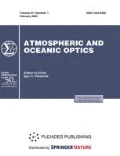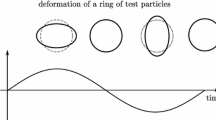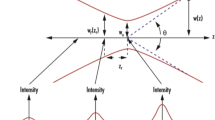Abstract
An eye-safe turbulent UV (355 nm) lidar BSE-5 designed for the study of atmospheric turbulence is described. Lidar works on the basis of the backscatter enhancement effect, which occurs when a light wave propagates twice in a random medium. The design of the lidar is based on a transceiving afocal Mersen telescope, which supports thermomechanical stability during long-term operation of the device. To reduce the telescope size, the edges of the primary mirror have been cut off, because they are not used during the lidar operation. The lidar was tested at Tolmachevo airport, Novosibirsk. During the tests, the turbulence was continuously monitored over a runway and over the aircraft parking. The lidar confidently recorded a turbulent wake of any aircraft during takeoff and landing. The lifetime of a strong artificial turbulence over the airfield was found to be 2–3 min.







Similar content being viewed by others
REFERENCES
A. S. Gurvich, “Lidar sounding of turbulence based on the backscatter enhancement effect,” Izv. Atmos. Ocean. Phys. 48 (6), 585–594 (2012).
A. S. Gurvich, “Lidar positioning of higher clear-air turbulence regions,” Izv. Atmos. Ocean. Phys. 50 (2), 143–151 (2014).
I. A. Razenkov, “Turbulent lidar: I—Design,” Atmos. Ocean. Opt. 31 (3), 273–280 (2018).
I. A. Razenkov, “Turbulent lidar: II—Experiment,” Atmos. Ocean. Opt. 31 (3) 281–289 (2018).
A. G. Vinogradov, A. S. Gurvich, S. S. Kashkarov, Yu. A. Kravtsov, and V. I. Tatarskii, Invention Certificate No. 359, Byull. Izobret., No. 21 (1989).
A. G. Vinogradov, Yu. A. Kravtsov, and V. I. Tatarskii, “Backscatter effect on bodies placed inside a randomly inhomogeneous medium,” Izv. Vyssh. Ucheb. Zaved. Radiofiz. 16 (7), 1064–1070 (1973).
V. V. Vorob’ev, “On the applicability of asymptotic formulas of retrieving "optical” turbulence parameters from pulse lidar sounding data: I—Equations,” Atmos. Ocean. Opt. 30 (2), 156–161 (2017).
I. A. Razenkov, “Estimation of the turbulence intensity from lidar data,” Atmos. Ocean. Opt. 33 (3), 245–253 (2020).
I. A. Razenkov, V. A. Banakh, and E. V. Gorgeev, “Lidar “BSE-4” for the atmospheric turbulence measurements,” Proc. SPIE—Int. Soc. Opt. Eng. (2018). https://doi.org/10.1117/12.2505183
N. N. Mikhel’son, Optical Telescopes (Nauka, Moscow, 1976) [in Russian].
I. A. Razenkov, “Optimization of parameters of a turbulent lidar,” Atmos. Ocean. Opt. 32 (3), 349–360 (2019).
http://jre.cplire.ru/jre/jan12/9/text.pdf. Cited December 17, 2019.
V. A. Banakh and I. A. Razenkov, “Lidar measurements of atmospheric backscattering amplification,” Opt. Spectrosc. 120 (2), 326–334 (2016).
D. P. Donovan, J. A. Whiteway, and A. I. Carswell, “Correction for nonlinear photon-counting effects in lidar systems,” Appl. Opt. 32 (33), 6742–6753 (1993).
A. L. Afanasiev, V. A. Banakh, and D. A. Marakasov, “Passive optical monitoring of wind conditions and indication of aircraft wakes near airport runways,” Atmo-s. Ocean. Opt. 32 (5), 506–510 (2019).
I. N. Smaliho, V. A. Banah, A. V. Falits, and A. A. Suharev, “Experimental study of aircraft wake vortices on the airfield of Tolmachevo airport in 2018,” Atmos. Ocean. Opt. 33 (2), 124–133 (2020).
A. A. Azbukin, A. Ya. Bogushevich, V. P. Lukin, V. V. Nosov, E. V. Nosov, and A. V. Torgaev, “Hardware-software complex for studying the structure of the fields of temperature and turbulent wind fluctuations,” Atmos. Ocean. Opt. 31 (5), 479–485 (2018).
ACKNOWLEDGMENTS
We are grateful to our opticians O.A. Rynkov and K.A. Rynkov.
Funding
The work was supported by the Russian Academy of Sciences (Fundamental Research Project No. AAAA-A17-117021310149-4).
Author information
Authors and Affiliations
Corresponding author
Ethics declarations
The authors declare that they have no conflicts of interest.
Additional information
Translated by O. Ponomareva
Rights and permissions
About this article
Cite this article
Razenkov, I.A., Nadeev, A.I., Zaitsev, N.G. et al. Turbulent UV Lidar BSE-5. Atmos Ocean Opt 33, 406–414 (2020). https://doi.org/10.1134/S1024856020040107
Received:
Revised:
Accepted:
Published:
Issue Date:
DOI: https://doi.org/10.1134/S1024856020040107




